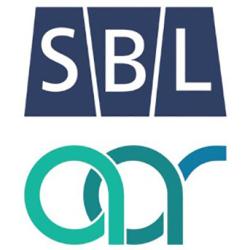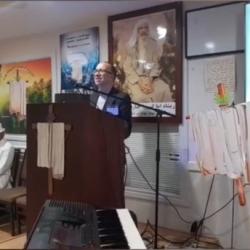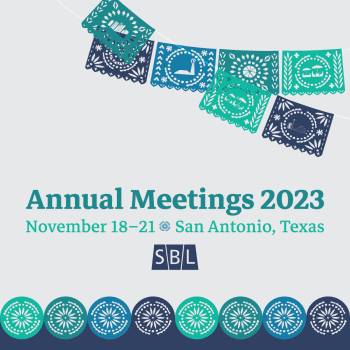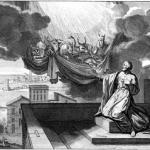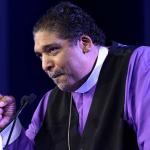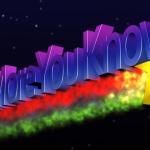Here is a round-up of what’s going on at this year’s Society of Biblical Literature and American Academy of Religion annual meetings on the subject of the Mandaeans and their literature (including one by yours truly):
S18-134: Nag Hammadi and Gnosticism
11/18/2012
9:00 AM to 11:30 AM
Room: S505a – McCormick Place
Revisiting the Relationship between the Mandaean Book of John and the New Testament
James F. McGrath, Butler University
During the first half of the twentieth century, there were circles in which one could practically take for granted that Mandaean sources stemmed from followers of John the Baptist, and thus provided the background for at least some sections of early Christianity (as Rudolf Bultmann famously maintained in relation to the Gospel of John, for instance). The tide turned against this view, and not without reason. But for the most part the specific claims made by critics of that stance did not do justice to the Mandaean sources any more than the scholars whose views they opposed. Since then, additional Mandaean texts have been published, and English translations of works previously unavailable in English are underway. Moreover, since then the Nag Hammadi texts have been published and allow for the question of the relationship between Mandaean and Christian sources, and between Mandaeism and Christianity, to be correlated with other Gnostic sources that were not available in the time of Reitzenstein and Bultmann on the one hand, and their critics such as Dodd on the other. On the one hand, the date of the Mandaean sources makes it inherently more likely that similarities and overlaps with New Testament texts are due to interaction with those texts and with Christianity on the part of the Mandaeans, rather than vice versa. On the other hand, many features of the Mandaean treatment of the figure of John the Baptist, his parents, and his wife and children, are not easily accounted for in these terms. This paper examines whether dependence in one direction or another, mutual dependence on earlier tradition, or some combination of all of these types of interaction best accounts for the similarities and differences between the Mandaean Book of John and the Gospels of Luke and John in the New Testament in particular.
S19-213: Corpus Hellenisticum Novi Testamenti
11/19/2012
1:00 PM to 3:30 PM
Room: W474b – McCormick Place
Sorcery in the Stars: From Mesopotamian Tablets to the Mandaic Book of the Zodiac
JoAnn Scurlock, Elmhurst College
The texts, which we will examine here, give a rare opportunity to watch the development of a system of thought. In the Neo-Assyrian STT 300, sorcerous rites reaching north Syria show that the basis of Greco-Egyptian Hellenistic magic and theurgy had been laid before the demise of the Assyrian empire. Of astrology properly speaking there is, however, yet no trace. By the late Persian or early Seleucid period, by contrast, astrology has placed itself at the center of interfacing between the traditional sciences of Mesopotamia and the new “wisdom.” By the Sassanian period, as represented by the Mandaic Book of the Zodiac, various discrepancies had been ironed out into a consistent system. In the process, the sorcerous rites seem once again to have been relegated to the fringe of intellectual life but some of the values attached to specific signs of the zodiac lived on.
S19-237: Religious World of Late Antiquity
11/19/2012
1:00 PM to 3:30 PM
Room: S504d – McCormick Place
Becoming a People of the Book: How Exposure to Islam may have Facilitated the Codification of Mandaean Religious Literature
Jennifer Hart, Stanford University
This paper is an exploration of the theory that one of the leading factors that brought about a codification of Mandaean religious literature was a Mandaean desire to be able to present their community as a people of the book (ahl al-kitab) and thereby gain protected status (ahl al-dhimmi) within the newly forming Muslim Empire. I present a three part argument for recognizing exposure to Islam and a concern for how Mandaeism would be perceived by Muslims as a motive for the redaction and consolidation of the primary theological texts of the Mandaean corpus. In part one, we consider evidence from the colophons of Mandaeism’s two main books, the Ginza and The Book of John, which demonstrates that although some of the writings that make up these composite texts predate Islam it was during the Islamic period that both the Ginza and The Book of John emerged as fully formulated pieces of religious literature. An analysis of the extensive scribal lists that accompany these books demonstrates that they were first compiled soon after the Muslims began to establish themselves as the new ruling elite in Persian Gulf marshlands that the Mandaeans called home. Moving from the scribal lists to the commentary that the scribes interspersed among their names, the second part of the paper focuses on instances in which the scribes self-consciously attest to their efforts to actively create an authoritative textual tradition for the Mandaeans during the first century of Muslim rule. Of particular interest in these examples is one scribe’s description of his canonizing ambitions that closely parallels early Muslim accounts of the process by which the Qur’an was recorded. In the third part of the paper, we turn our attention to another important Mandaean text, Haran Gawaita, which includes a supposedly historical narrative about how a prominent member of the Mandaean community presented Muhammad with “the Mandaean book” and thereby secured protected status for the Mandaeans. This story, together with the evidence treated in parts one and two of the paper strongly suggest that the Mandaeans were aware of the benefits to be gained by being labeled as people of the book, and as such they underwent a process of codifying their literature so as to claim this title.
S19-302: Aramaic Studies
11/19/2012
4:00 PM to 6:30 PM
Room: N133 – McCormick Place
Incantation Texts as a Witness to Mandaean Scripture
Charles G. Häberl, Rutgers University
In contrast with the testimony of the Mandaean manuscripts and external witnesses about Mandaeism in antiquity, the archaeological record seems quite sparse. The Mandaeans have not left behind distinctive architectural remains, ceramic assemblages, specie, or any other examples of the plastic arts. The sole archaeological witnesses to the presence of Mandaeans in the region are the incantation texts composed in the Mandaic script and either inscribed upon pottery bowls or incised into sheets of metal. The former date between the fifth and the eighth century CE, and the latter likely belong to a slightly earlier date, between the fourth and the seventh century. The distribution of these text corresponds closely to the evidence provided by the Mandaean literature and the external witnesses during the Sasanian and early Islamic eras. These texts represent the Mandaean contribution to a broader corpus of incantations that transcend confessional boundaries, and appear in different scripts reflecting different religious traditions, imparting much valuable information about the religions of those who composed them. Some of the earliest Mandaic incantations, such as the lead amulet published by Lidzbarski, attest to a developed Mandaean theology. While none of the incantation bowls thus far discovered reproduce any substantial portion of the canonical Mandaean scriptures, they do frequently incorporate individual formulae also found within Mandaean scripture, raising intriguing questions about the relationship of these two corpora that have thus far not been addressed.
And then, on the AAR side, those names and more reappear in this session:
A18-233: Exploratory Sessions
Theme: Late Antiquity East
Jorunn Buckley, Bowdoin College, Presiding
Sunday – 1:00-2:30 PM
MPN-135
Scholars who work in “Late Antiquity East” have long been somewhat homeless in the AAR /SBL. There is no Zoroastrian slot anymore, nor a Manichaean one. We aim to gather interested fellow-scholars for a consultation at the AAR Annual meeting in Chicago, Nov 2012, to discuss how we can establish a new unit in the AAR for our interrelated fields of study. We are not Bible-oriented, but work in areas such as: eastern forms of early Christianity, Manichaeism, Zoroastrianism, late Babylonian religion, Jewish eastern traditions, and Mandaeism.
Panelists:
James McGrath, Butler University
Naomi Koltun-Fromm, Haverford College
Yuhan Vevaina, Stanford University
Charles Häberl, Rutgers University
Zsuzsanna Gulácsi, Northern Arizona University
John Reeves, University of North Carolina, Charlotte
Alexander Treiger, Dalhousie University
Jason BeDuhn, Northern Arizona University
Jennifer Hart, Stanford University
UPDATE: Here’s another SBL paper the abstract of which, while not mentioning the Mandaeans explicitly, implies that they will be a focus:
S20-109: Construction of Christian Identities
11/20/2012
9:00 AM to 11:30 AM
Room: N136 – McCormick Place
Theme: “Early Groups of Jesus’ Followers: A Survey of the First Two Centuries.”
Following the Footsteps of Ancient Baptists from the Fathers to the Scholars
Gerhard van den Heever, University of South Africa
The variety of early Jesus or Christ cult groups has to be surmised from under the veneer of a seemingly mono-origined and unitary Christian movement as exemplified and embodied in the codified mythmaking process that spans the earliest canonical apostolic writings through the early fathers to later heresiological tradition. It is especially the polemics so characteristic of the emerging mainstream tradition that testify to the existence of a variety of early Jesus or Christ cult groups. However, while the names of founders and Christ cult groups proliferate in our sources, the identification and accurate description of the character of these groups is notoriously fraught with difficulty due to the polemically biased and fragmentary nature of the references. This is especially true with regard to cult groups identified as Jewish-Christian. From F. C. Baur to the present, scholarly reconstructions of (what came to be known conventionally as) Jewish Christianity have produced many collections and critical editions of fragments, citations, and the rhetorical and polemical contexts of these citations in mainstream Christian literature, but the precise nature of Jewish-Christian cult group identities and their relation to other strands of tradition (‘orthodox’, Gnostic, etc.) is much more difficult to delineate. The recoverable Jewish-Christian traditions suggest that the interaction and interplay between the later (so-identified) Judaism and Christianity must have been much more complex in the earlier centuries. The thesis explored in this paper holds that there is a broad continuity spanning such utopian Jewish groups as the Qumran Essenes (Doron Mendels), through various types of baptist millennial groups in the ancient Near East. Jewish-Christian cult groups existed on the fringes of these, and in various configurations continued to exist into later Gnosticising traditions. In this paper an attempt is made towards a more accurate social contextualisation of Jewish-Christian groups by starting not so much from what is known about the groups and their leaders from the sources (or the contents of their theologies), but from the opposite end, namely to trace the evidences for a spectrum of ritual practices broadly characterised as water lustrations. The many indications of interpretations of rituals of washing as purification, as well as a framing of these by apocalyptic discourse, enable us to reconstruct a trajectory of doomsday, world-renouncing, counter-cultural groups which reconstruction is informed by cross-cultural comparisons for greater applicability and accuracy in theorising of ‘heterodox’ Jewish-Christian cult groups. As such this paper advances the position that cross-cultural studies in discourse, ritual, and identity formation can greatly assist in drawing more detailed pictures of Jewish-Christian hybrid identity formations. In this, simultaneously, an evaluation is made of the tradition of scholarship on ancient baptismal cult groups from Joseph Thomas (1935), through Kurt Rudolph (1981) to the present day (inter alia, Marjanen/Luomanen, 2005).







